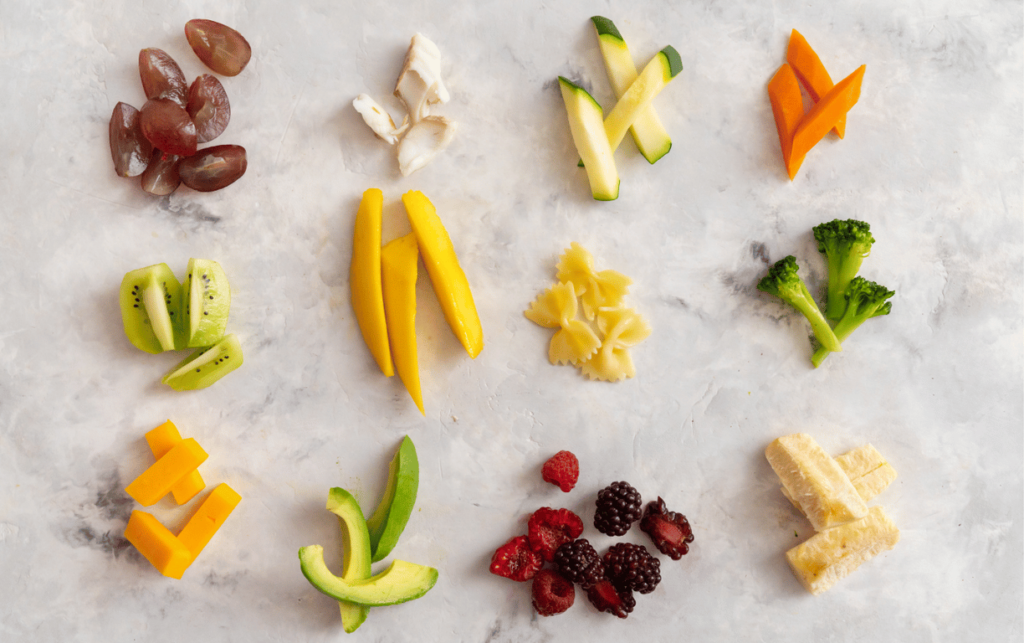Physical Address
304 North Cardinal St.
Dorchester Center, MA 02124
Physical Address
304 North Cardinal St.
Dorchester Center, MA 02124
As your baby explores the world of solid foods, finger snacks provide a fun and engaging way for them to practice self-feeding. Offering nutritious and safe options is key to helping your child develop healthy eating habits early on. You want snacks that are easy for little hands to grasp and chew, while also being packed with nutrients to support their growth.

Choosing the right finger snacks for your little one can feel overwhelming with all the options available. From soft fruits and vegetables to homemade treats, there are plenty of delicious choices you can provide. Creating a variety of snacks also helps in exposing your baby to different textures and flavors, making mealtime exciting.
Keep in mind the importance of safety and hygiene when preparing snacks. Learning how to avoid common allergens and ensuring that foods are appropriately cut can give you peace of mind. With the right knowledge, you can make snacking a positive experience for both you and your baby.
Finger snacks are great for encouraging your baby to eat and explore food. These snacks help develop their motor skills and independence.
You can start introducing finger snacks when your baby is around 6 to 8 months old. At this age, they can grasp and hold small pieces of food.
Here are some healthy finger snack ideas:
Make sure the food is cut into small, manageable pieces. This helps prevent choking and makes it easier for your baby to grasp the food.
It’s normal for babies to play with their food. This exploration is important for their learning. They may not eat everything, but that’s okay!
If you’re interested in baby-led weaning, consider using finger snacks instead of spoon-feeding. This method lets your little one learn how to eat independently.
Incorporating a variety of colors and textures will keep mealtime fun and exciting. Remember to supervise your baby while they eat to ensure safety. Happy snacking!
When choosing snacks for your baby, it’s important to focus on essential nutrients that support healthy growth and development. You want to ensure your little one gets a balanced intake of macronutrients, vitamins, and minerals, along with the right portion sizes to avoid choking hazards.
Babies need three main types of macronutrients: carbohydrates, proteins, and fats.
Aim for snacks that blend these macronutrients. For example, yogurt with blended fruit is both tasty and nutritious.
Vitamins and minerals play a crucial role in your baby’s health.
Incorporate snacks that include a mix of these vitamins and minerals to promote overall wellness. Offer fruits and veggies in a rainbow of colors for maximum nutrient variety.
Portion sizes are key to keeping your baby safe while snacking.
Always supervise your baby during snack time and adjust portion sizes based on their individual needs. Use your judgment to ensure snacks are age-appropriate and safe.
Choosing safe finger snacks for your baby is important for their health and development. You want snacks that are nutritious and easy for little hands to grab. Below are some great options to consider.
Fruits and vegetables are excellent choices for finger snacks. They are soft, colorful, and packed with vitamins.
Make sure to monitor your baby while eating to avoid any choking hazards. Always cut pieces into manageable sizes.
Grains are great for energy and brain development. They can be served in various forms that are easy for babies to pick up.
Grains support healthy digestion and can be offered in a variety of textures that are suitable for your baby’s growing skills.
Dairy products provide essential calcium for strong bones. If your baby is not allergic to dairy, consider these options.
Make sure to choose options that are low in added sugars and salt for healthy eating.
Protein is vital for your baby’s growth. Incorporate these protein-rich snacks into their diet.
Watch your baby closely as they explore new tastes and textures. Protein supports overall development and keeps little ones satisfied.
Making homemade baby snacks is simple and fun. You can choose healthy ingredients and control what goes into your baby’s food. Here are some easy ideas to get you started.
Fruits and Veggies
Chop soft fruits like bananas, avocados, or cooked sweet potatoes into small pieces. These can be easily picked up by little hands. Steamed vegetables like carrots or peas are also great options.
Grains
Consider making snacks with soft grains. Cooked oatmeal can be shaped into small bites. You can also try quinoa or couscous, which are both healthy and easy to handle.
Proteins
Small pieces of cooked chicken, turkey, or tofu can be great finger foods. These proteins help with growth and energy.
No-Bake Snacks
Try making no-bake energy balls. Combine oats, nut butter, and a bit of honey. Roll them into small balls for a sweet treat that’s easy to hold.
Storage Tips
Store snacks in airtight containers. This keeps them fresh for your little one. Consider freezing some snacks, like polenta bites, for a quick treat later.
Preparing snacks at home gives you peace of mind. You know exactly what your baby is eating and can make adjustments based on their taste preferences. Enjoy the process!

When introducing finger snacks to your baby, it’s crucial to be aware of potential allergies and intolerances. Knowing what foods to avoid and how to recognize reactions is important for keeping your little one safe. This section covers the most common allergens, how to detect reactions, and tips for introducing new foods.
Some foods are known to cause allergic reactions in babies. The most common allergens include:
Understanding these allergens can help you make safer food choices for your baby.
Recognizing allergy symptoms in your baby is vital. Common signs to watch for include:
If you notice any of these signs, it’s essential to consult your pediatrician. Keeping a food diary can help track what your baby eats and any reactions. Always be prepared with emergency contact information and know where to get medical assistance if needed.
When introducing new foods, especially allergens, do so one at a time. Here are some helpful tips:
Be sure to discuss your plans with your pediatrician. They may have specific guidelines based on your baby’s health history. This careful approach can help ensure a positive eating experience for your little one.

Keeping your baby’s food safe is very important. Here are some tips to help you ensure hygiene and safety when offering finger snacks.
1. Wash Your Hands
Always wash your hands with soap and water before preparing food. This helps remove germs and keeps your baby safe.
2. Clean Surfaces and Utensils
Make sure you clean all surfaces and utensils before using them. Wipe down countertops and cutting boards. Use hot, soapy water for utensils.
3. Choose Safe Foods
Avoid foods that can pose a choking hazard. Some examples include whole grapes, nuts, and large pieces of raw vegetables. Stick to soft, easily manageable snacks.
4. Proper Food Storage
Store any prepared food in the refrigerator. Make sure to eat it within two days. If it has been sitting out for more than two hours, throw it away.
5. Supervise Meal Time
Always watch your baby while they are eating. This allows you to catch any problems right away. If your baby starts to choke, know how to respond.
By following these simple steps, you can help make snack time safer for your little one. Enjoy these moments together!
Finding healthy and tasty finger snacks for your baby can be fun! Here are some great ideas to try.
These snacks are simple and nutritious. Enjoy creating mealtime fun with your little one! For more finger food recipes, check the ultimate list of baby finger foods.
When you’re out and about with your little one, having healthy finger snacks ready can make a big difference. It helps keep your baby happy and satisfied while you’re on the move. Here are some important tips for packaging and temperature when it comes to on-the-go snacks.
Choosing the right packaging for your baby’s snacks is key. Look for containers that are easy to open but also seal tightly to keep the food fresh.
Make sure to include a few spoons or forks if your baby needs them. Always pack extra napkins to clean up any mess!
You can prepare these snacks ahead of time. Just store them in the fridge and grab them when you head out. This way, you won’t be scrambling at the last minute.
Temperature plays a big role in keeping snacks safe and tasty. If your snacks need to stay cool, use insulated bags or ice packs.
When packing, always check that food stays within safe temperature zones. This will help avoid any health risks for your baby. Be mindful of how long your snacks should remain out. Ideally, try to consume perishable items within two hours. Stay prepared and enjoy your outings!
Introducing snacks into your baby’s diet can be fun and beneficial. Start with small quantities and watch how your baby responds. This helps them explore different tastes and textures safely.
Ideas for Healthy Snacks:
Always ensure the snacks are appropriate for your baby’s age and stage of eating. Cut food into small, manageable pieces. This reduces the risk of choking.
You can offer snacks between meals to keep your baby satisfied. It also helps them learn about different food options. For younger babies, choose smoother snacks. As they grow, introduce more textured foods.
Snacks should be nutritious. Aim for a mix of flavors and colors. This not only makes meals exciting but also provides a range of nutrients.
Pay attention to your baby’s cues. If they seem full, don’t force more food. Encourage your little one to try new snacks, but let them lead the way. Enjoy this journey of introducing solid foods together!
If you’re looking for guidance on finger snacks for your baby, there are many common questions that parents ask. This section covers age-appropriate snacks, options for babies without teeth, and easy recipes to try.
For babies aged 6 to 12 months, soft and easy-to-grasp snacks are ideal. Some good choices include small pieces of ripe banana, cooked sweet potato, and soft-cooked peas. You can also try pieces of avocado and small, soft muffins.
Yes, babies without teeth can still enjoy finger foods. Soft foods that can be easily gummed are perfect. You might offer cooked carrots, soft bread, or ripe fruit like pears and bananas. These options are not only safe but also tasty for your baby.
For young babies, it’s best to stick to soft finger foods. Cooked vegetables, like zucchini and squash, are great options. Oatmeal cookies and scrambled eggs cut into small pieces are also yummy and easy for your baby to eat.
Easy-to-prepare finger snacks include items like sliced fruit, such as apples and melons, if very soft. Plain yogurt with small pieces of fruit mixed in is another simple choice. You can also mash cooked potatoes and form them into small patties for your baby to hold.
Babies often begin trying finger foods around 6 months. By this age, many are ready to explore solid foods and can handle self-feeding. It’s essential to watch your baby’s readiness and follow their cues for when to introduce finger foods.
A 10-month-old might refuse finger foods due to teething discomfort or simply because they have preferences. If this happens, try offering a variety of textures and flavors. You can also make the foods more appealing by presenting them in fun shapes or colors.